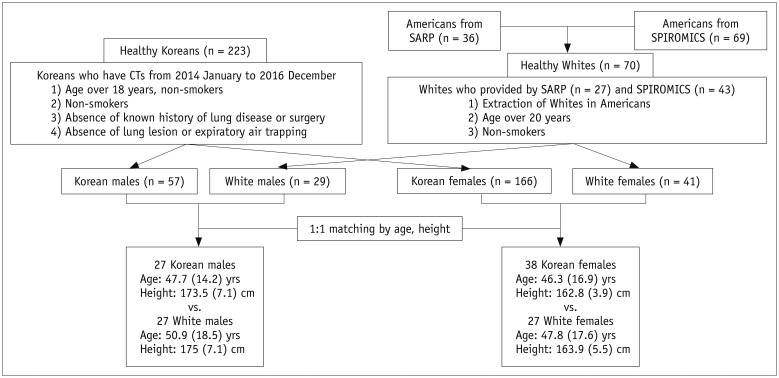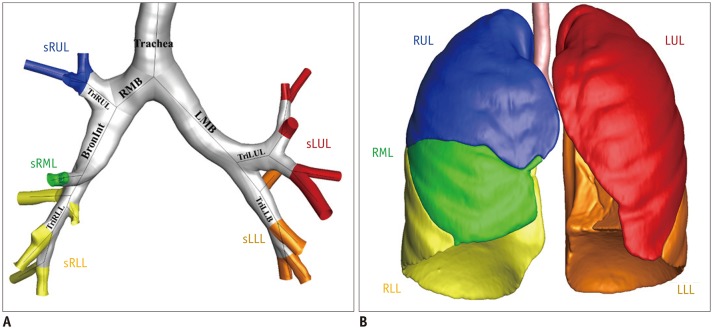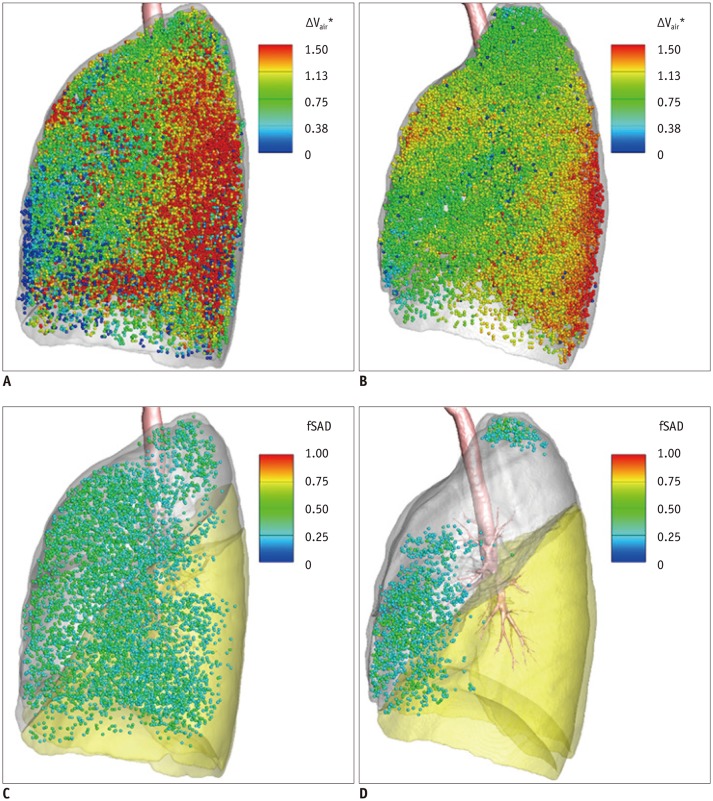Korean J Radiol.
2019 Jul;20(7):1236-1245. 10.3348/kjr.2019.0083.
Structural and Functional Features on Quantitative Chest Computed Tomography in the Korean Asian versus the White American Healthy Non-Smokers
- Affiliations
-
- 1School of Mechanical Engineering, Kyungpook National University, Daegu, Korea. s-choi@knu.ac.kr
- 2Department of Radiology, Research Institute of Clinical Medicine of Chonbuk National University-Biomedical Research Institute of Chonbuk National University Hospital, Jeonju, Korea.
- 3Department of Mechanical Engineering, The University of Iowa, Iowa City, IA, USA.
- 4IIHR-Hydroscience and Engineering, The University of Iowa, Iowa City, IA, USA.
- 5Department of Radiology, College of Medicine, The University of Iowa, Iowa City, IA, USA. changhyun.lee@snu.ac.kr
- 6Department of Biomedical Engineering, The University of Iowa, Iowa City, IA, USA.
- 7Division of Pulmonary, Allergy and Critical Care Medicine, University of Pittsburgh, Pittsburgh, PA, USA.
- 8Departments of Internal Medicine and Pediatrics, Washington University School of Medicine, St. Louis, MO, USA.
- 9Departments of Radiology and Medicine, School of Medicine and Public Health, University of Wisconsin, Madison, WI, USA.
- 10Department of Medical Physics and Biomedical Engineering, University of Wisconsin, Madison, WI, USA.
- 11Departments of Medicine and Epidemiology, Columbia University Medical Center, New York, NY, USA.
- 12School of Medicine, Johns Hopkins University, Baltimore, MD, USA.
- 13Department of Physiology, University of California, Los Angeles, CA, USA.
- 14Department of Medicine, University of California, Los Angeles, CA, USA.
- 15Department of Internal Medicine, University of Michigan, Ann Arbor, MI, USA.
- 16School of Medicine, University of California at San Francisco, San Francisco, CA, USA.
- 17School of Medicine, University of Utah, Salt Lake City, UT, USA.
- 18Departments of Genetics and Genomics and Precision Medicine, University of Arizona Health Sciences, Tucson, AZ, USA.
- 19Department of Internal Medicine, Wake Forest University School of Medicine, Winston-Salem, NC, USA.
- 20Department of Radiology, Seoul National University Hospital, Seoul, Korea.
- KMID: 2467034
- DOI: http://doi.org/10.3348/kjr.2019.0083
Abstract
OBJECTIVE
Considering the different prevalence rates of diseases such as asthma and chronic obstructive pulmonary disease in Asians relative to other races, Koreans may have unique airway structure and lung function. This study aimed to investigate unique features of airway structure and lung function based on quantitative computed tomography (QCT)-imaging metrics in the Korean Asian population (Koreans) as compared with the White American population (Whites).
MATERIALS AND METHODS
QCT data of healthy non-smokers (223 Koreans vs. 70 Whites) were collected, including QCT structural variables of wall thickness (WT) and hydraulic diameter (Dh) and functional variables of air volume, total air volume change in the lung (ΔVair), percent emphysema-like lung (Emph%), and percent functional small airway disease-like lung (fSAD%). Mann-Whitney U tests were performed to compare the two groups.
RESULTS
As compared with Whites, Koreans had smaller volume at inspiration, ΔVair between inspiration and expiration (p < 0.001), and Emph% at inspiration (p < 0.001). Especially, Korean females had a decrease of ΔVair in the lower lobes (p < 0.001), associated with fSAD% at the lower lobes (p < 0.05). In addition, Koreans had smaller Dh and WT of the trachea (both, p < 0.05), correlated with the forced expiratory volume in 1 second (R = 0.49, 0.39; all p < 0.001) and forced vital capacity (R = 0.55, 0.45; all p < 0.001).
CONCLUSION
Koreans had unique features of airway structure and lung function as compared with Whites, and the difference was clearer in female individuals. Discriminating structural and functional features between Koreans and Whites enables exploration of inter-racial differences of pulmonary disease in terms of severity, distribution, and phenotype.
Keyword
MeSH Terms
Figure
Reference
-
1. Song WJ, Kang MG, Chang YS, Cho SH. Epidemiology of adult asthma in Asia: toward a better understanding. Asia Pac Allergy. 2014; 4:75–85. PMID: 24809012.
Article2. Iqbal S, Oraka E, Chew GL, Flanders WD. Association between birthplace and current asthma: the role of environment and acculturation. Am J Public Health. 2014; 104(Suppl 1):S175–S182. PMID: 24354818.
Article3. Adeloye D, Chua S, Lee C, Basquill C, Papana A, Theodoratou E, et al. Global Health Epidemiology Reference Group (GHERG). Global and regional estimates of COPD prevalence: systematic review and meta-analysis. J Glob Health. 2015; 5:020415. PMID: 26755942.
Article4. Krishnaswamy S, Kanteti R, Duke-Cohan JS, Loganathan S, Liu W, Ma PC, et al. Ethnic differences and functional analysis of MET mutations in lung cancer. Clin Cancer Res. 2009; 15:5714–5723. PMID: 19723643.
Article5. Yang TS, Peat J, Keena V, Donnelly P, Unger W, Woolcock A. A review of the racial differences in the lung function of normal Caucasian, Chinese and Indian subjects. Eur Respir J. 1991; 4:872–880. PMID: 1955009.6. Whittaker AL, Sutton AJ, Beardsmore CS. Are ethnic differences in lung function explained by chest size? Arch Dis Child Fetal Neonatal Ed. 2005; 90:F423–F428. PMID: 15871993.
Article7. Hoffman EA, Ahmed FS, Baumhauer H, Budoff M, Carr JJ, Kronmal R, et al. Variation in the percent of emphysema-like lung in a healthy, nonsmoking multiethnic sample. The MESA lung study. Ann Am Thorac Soc. 2014; 11:898–907. PMID: 24983825.
Article8. Kim SS, Jin GY, Li YZ, Lee JE, Shin HS. CT quantification of lungs and airways in normal Korean subjects. Korean J Radiol. 2017; 18:739–748. PMID: 28670169.
Article9. Choi S, Hoffman EA, Wenzel SE, Castro M, Fain SB, Jarjour NN, et al. Quantitative assessment of multiscale structural and functional alterations in asthmatic populations. J Appl Physiol (1985). 2015; 118:1286–1298. PMID: 25814641.
Article10. Choi S, Haghighi B, Choi J, Hoffman EA, Comellas AP, Newell JD, et al. Differentiation of quantitative CT imaging phenotypes in asthma versus COPD. BMJ Open Respir Res. 2017; 4:e000252.
Article11. Choi S, Hoffman EA, Wenzel SE, Tawhai MH, Yin Y, Castro M, et al. Registration-based assessment of regional lung function via volumetric CT images of normal subjects vs. severe asthmatics. J Appl Physiol (1985). 2013; 115:730–742. PMID: 23743399.
Article12. Choi S, Hoffman EA, Wenzel SE, Castro M, Lin CL. Improved CT-based estimate of pulmonary gas trapping accounting for scanner and lung-volume variations in a multicenter asthmatic study. J Appl Physiol (1985). 2014; 117:593–603. PMID: 25103972.
Article13. Choi S, Hoffman EA, Wenzel SE, Castro M, Fain S, Jarjour N, et al. National Heart, Lung and Blood Institute's Severe Asthma Research Program. Quantitative computed tomographic imaging-based clustering differentiates asthmatic subgroups with distinctive clinical phenotypes. J Allergy Clin Immunol. 2017; 140:690–700.e8. PMID: 28143694.
Article14. Moore WC, Bleecker ER, Curran-Everett D, Erzurum SC, Ameredes BT, Bacharier L, et al. National Heart, Lung, Blood Institute's Severe Asthma Research Program. Characterization of the severe asthma phenotype by the National Heart, Lung, and Blood Institute's Severe Asthma Research Program. J Allergy Clin Immunol. 2007; 119:405–413. PMID: 17291857.
Article15. Couper D, LaVange LM, Han M, Barr RG, Bleecker E, Hoffman EA, et al. SPIROMICS Research Group. Design of the Subpopulations and Intermediate Outcomes in COPD Study (SPIROMICS). Thorax. 2014; 69:491–494.16. Crapo RO, Hankinson JL, Irvin C, Maclntyre NR, Voter KZ, Wise RA, et al. Standardization of Spirometry, 1994 update. American Thoracic Society. Am J Respir Crit Care Med. 1995; 152:1107–1136. PMID: 7663792.
Article17. Jahani N, Choi S, Choi J, Iyer K, Hoffman EA, Lin CL. Assessment of regional ventilation and deformation using 4D-CT imaging for healthy human lungs during tidal breathing. J Appl Physiol (1985). 2015; 119:1064–1074. PMID: 26316512.
Article18. Hoff BA, Pompe E, Galbán S, Postma DS, Lammers JJ, Ten Hacken NHT, et al. CT-based local distribution metric improves characterization of COPD. Sci Rep. 2017; 7:2999. PMID: 28592874.
Article19. Mann HB, Whitney DR. On a test of whether one of two random variables is stochastically larger than the other. Ann Math Statist. 1947; 18:50–60.
Article20. Lawrence MA. Easy analysis and visualization of factorial experiments. R package version 4.1-1. 2012. Available at: https://cran.r-project.org/web/packages/ez/ez.pdf.21. Korotzer B, Ong S, Hansen JE. Ethnic differences in pulmonary function in healthy nonsmoking Asian-Americans and European-Americans. Am J Respir Crit Care Med. 2000; 161(4 Pt 1):1101–1108. PMID: 10764297.
Article22. Becklake MR, Kauffmann F. Gender differences in airway behaviour over the human life span. Thorax. 1999; 54:1119–1138. PMID: 10567633.
Article23. Peat JK, Salome CM, Woolcock AJ. Factors associated with bronchial hyperresponsiveness in Australian adults and children. Eur Respir J. 1992; 5:921–929. PMID: 1426199.
- Full Text Links
- Actions
-
Cited
- CITED
-
- Close
- Share
- Similar articles
-
- Longitudinal Evaluation of Lung Function Associated with Emphysema in Healthy Smokers
- Erratum: Structural and Functional Features on Quantitative Chest Computed Tomography in the Korean Asian versus the White American Healthy Non-Smokers
- Quantitative CT Analysis Based on Smoking Habits and Chronic Obstructive Pulmonary Disease in Patients with Normal Chest CT
- Health-related Quality of Life in Elderly Asian American and Non-Hispanic White Cancer Survivors
- CT Quantification of Lungs and Airways in Normal Korean Subjects




